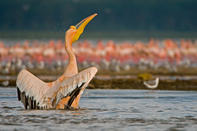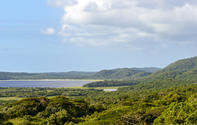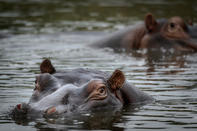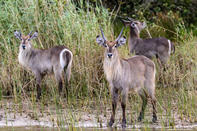iSimangaliso Wetland Park
The 332,000 hectare Wetland Park consisting of the Maputaland estuarine lake system, coastal grasslands, coastal sand, dune forest and tropical beaches is biologically so diverse and with such dramatic scenery that the local people call it Simangaliso - the miracle. The wetlands include the St Lucia and Kosi estuaries and freshwater lakes Sibaya, Ngobozeleni, and Bhangazi North and South, creating the largest coastal lake system in Africa.
On dry land the world's oldest land mammal, the rhino, lives together with the largest mammal, the elephant, along with the rest of the Big Five and many other species of game. In 1890 the area was declared a game reserve. In time the value of the wetlands became apparent, with huge populations of Nile crocodiles (around 2,000) and hippos (around 1, 300). In 1939 the wetlands were declared a provincial park and in 1971 a RAMSAR wetland of international importance.
In 1999, on account of its exceptional biodiversity, combined with the pioneering community partnership initiated here, the St Lucia Wetland Park became South Africa's first World Heritage Site.
The Greater St Lucia Wetlands

Various Nguni tribes live in the area mainly as subsistence farmers, speaking either Zulu or Tsonga. The Thonga people have been living along this coast for several centuries, all the time tending and repairing the fence-like wooden fish traps that create swirling patterns in the Kosi estuary mouth. The greater St Lucia wetlands are critical habitat for more than just impressive giant reptiles and amphibious mammals (of passing interest is the recently discovered fact that hippos are most closely related to whales). The extensive mangroves, swamp forest, papyrus, reed beds and sedges play a vital role in the production of plant detritus that forms the basis of the entire lake food chain.
The lake ecosystem has extremely high productivity by any and as a result it has a very high species count for an environment that is at times stressed by flood and drought, the inflow of fresh and salt water - or none at all. The 82 species of fish recorded include larvae and fingerlings of numerous species that use the estuaries as nurseries. This is a role often overlooked by engineers and coastal planners, who later wonder where all the fish went.
Also of note is that St Lucia has South Africa's largest populations of both white and pink-backed pelicans, which are voracious fish eaters. 'The lake and wetlands harbour 340 different kinds of birds and are a crucial habitat for many migratory waterfowl and wetland species.
Forested Dunes of the Eastern Shores

The standout land feature of the Eastern Shores section of the wetland park are the forested coastal dunes that have been sculpted by wind and wave action for around 25 000 years. They soar up to 180 metres and are believed to be the highest vegetated dungs in Africa. They play an important rain-catching function, the wind that brings the moisture stunting the vegetation on the seaward side and promoting a lush, high forest canopy on the leeward side.
A cacophony of forest birds creates a wall of noise, the trumpeter hornbills adding to the sounds of the robin-chats, bush shrikes, bush warblers and many others. (Robin-chats and drongos can imitate other birds, mammals and even cow herders' whistles). In quiet places shy antelope - red and common duiker, bushbuck and kudu - lurk in the milky half-light. But the real jesters of the canopy are the samango monkeys that chuckle and grunt, croak and screech.
The trees most conspicuous around Thonga Beach Lodge are coastal red milkwoods (Mimusops caffra) that create the intertwined canopy over the paths and main eating deck.
A rare forest giant is the Lebombo wattle (Newtonia hildebrandtil) that is a protected species. The palms you will see on the forest margin and around the hamlets are ilala palms (Hyphaene natalensis), from which a palm wine is made. When distilled it makes a local variety of white lightning, which might account for the local name: to lala means to sleep. The red heart-fruit (Hymenocardia ulmoides) has wood that is resilient, straight, strong and elastic, making it the ideal material for the fish traps in the Kosi mouth.

